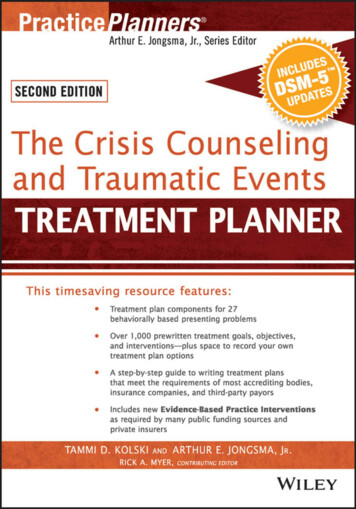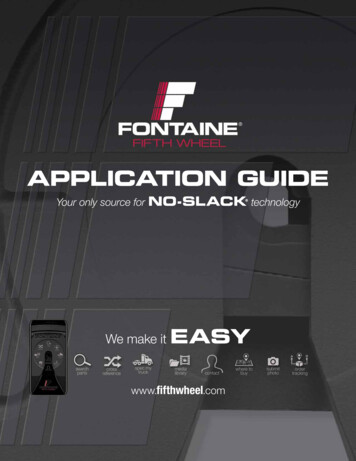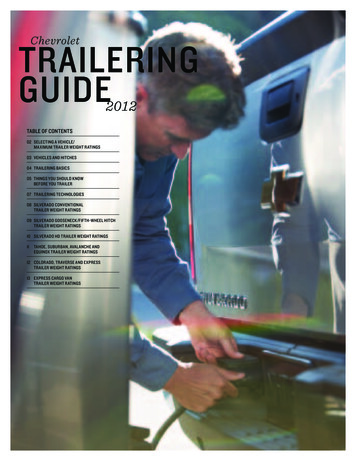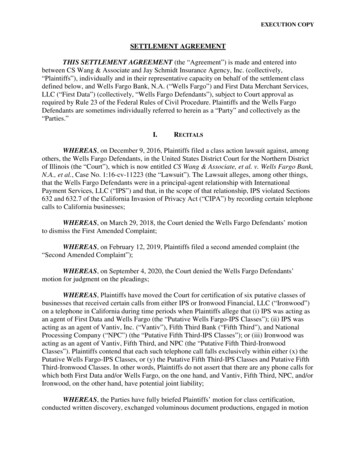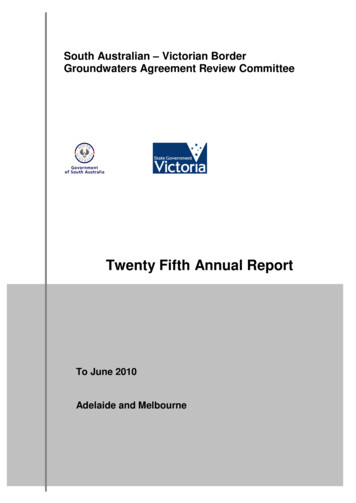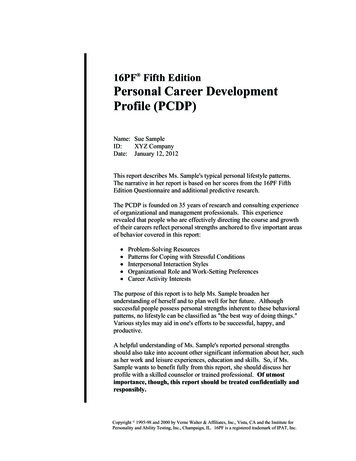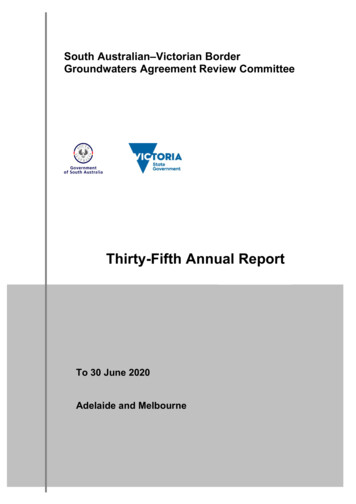
Transcription
South Australian–Victorian BorderGroundwaters Agreement Review CommitteeThirty-Fifth Annual ReportTo 30 June 2020Adelaide and Melbourne
Managing groundwater resources across the South Australian–Victorian borderThe Border Groundwaters AgreementAuthorised and published by the Victorian Government,Department for Environment, Land, Water and Planning, 8Nicholson Street, East Melbourne 2002 and by the SouthAustralian Government, Department for Environment andWater. The State of Victoria Department of Environment, Land,Water and Planning 2020This work is licensed under a CreativeCommons Attribution 4.0 Internationallicence. You are free to re‐use the work under thatlicence, on the condition that you credit the State ofVictoria as author. The licence does not apply to anyimages, photographs or branding, including the VictorianCoat of Arms, the Victorian Government logo and theDepartment of Environment, Land, Water and Planning(DELWP) logo. To view a copy of this licence, cessibilityIf you would like to receive this publication in analternative format, please telephone the DELWPCustomer Service Centre on 136186,email customer.service@delwp.vic.gov.au , or via theNational Relay Service on 133 677www.relayservice.com.au.ISSN 2203‐1596 (print)ISSN 2203‐1650 (online)DisclaimerThis publication may be of assistance to you but the Stateof Victoria and the State of South Australia and itsemployees do not guarantee that the publication iswithout flaw of any kind or is wholly appropriate for yourparticular purposes and therefore disclaims all liability forany error, loss or other consequence which may arisefrom you relying on any information in this publication.Border Groundwaters Agreement Review CommitteeThirty-Fifth Annual Report – To 30 June 2020PAGE 2
Managing groundwater resources across the South Australian–Victorian borderThe Border Groundwaters AgreementPREFACEThe Border Groundwaters Agreement Review Committee’s Annual Report for 2019-20 fulfilsthe requirement under clause 30(1) of the Border Groundwaters Agreement to report on itsactivities during the year to 30 June 2020. This report has been compiled with reference toreports from South Australia and Victoria.Clause 30(2) requires the Review Committee to forward a copy of the report to the appropriateMinister in each government.Section 11 of the Victorian Groundwater (Border Agreement) Act 1985, and section 13 of theSouth Australian Groundwater (Border Agreement) Act 1985 provides that the relevantminister shall cause a copy of the annual report to be laid before the parliament within fourteensitting days of the receipt of the report.Border Groundwaters Agreement Review CommitteeThirty-Fifth Annual Report – To 30 June 2020PAGE 3
Managing groundwater resources across the South Australian–Victorian borderThe Border Groundwaters AgreementTABLE OF CONTENTS1.The year in summary52.About the Agreement and the Review Committee63.The South Australian–Victorian Border Groundwaters Agreement6Border Groundwaters Agreement Review Committee7General Information9Groundwater resources in the South Australian–Victorian border region9Management approach9Permissible Annual Volumes and Allowable Annual Volumes12Allocations and volumes extracted13Permissible distance from the border15Permissible potentiometric surface lowering16Permissible salinity17Accounting for the impacts of plantation forests on groundwater resources17Reports from the states17FIGURESFigure 1: The Designated Area and zones20Figure 2: Relationship of management areas in South Australia and Victoria to theDesignated Area21Figure 3: Hydrogeological provinces22Figure 4: Schematic hydrostratigraphic cross-sections relating to Figure 323Figure 5: Sub-zone boundaries for Zones 1A, 6A and 9A24Figure 6: Volume extracted from the Tertiary Limestone Aquifer since 2006/0725Figure 7: Groundwater-level trends for the Tertiary Limestone Aquiferwith some representative hydrographs26Figure 8: Groundwater-level trends for the Tertiary Confined Sand Aquifer with somerepresentative der Groundwaters Agreement Review CommitteeThirty-Fifth Annual Report – To 30 June 2020PAGE 4
Managing groundwater resources across the South Australian–Victorian borderThe Border Groundwaters Agreement1.The year in summaryAlong the South Australian–Victorian border, groundwater is the only reliable natural watersource. It is used extensively in both states for irrigation, industry and public water supplies,as well as livestock and domestic uses. While groundwater supplies are relatively secure, theBorder Groundwaters Agreement Review Committee (Review Committee) has sought tocontinually improve the technical understanding of the resources to inform a review of themanagement prescriptions defined by the Agreement to maintain the ongoing sustainable andequitable use of groundwater along the South Australian–Victorian border.The Review Committee has completed a comprehensive review of the Agreement; itsusefulness, relevancy and suitability in terms of objectives for managing the groundwaterresources both equitably and sustainably along the border. The approach taken was one ofcollaboration between the two Contracting Governments and members of the ReviewCommittee. The review has considered the outcomes delivered by the Agreement and howthese can be improved to better protect and manage the groundwater into the future whilemaintaining the principle of equitable sharing of the resource. The Review Committee is nowpreparing to consult with both Contracting Governments in 2020-21 to discuss its proposedrecommendations for building on the current arrangements, to ensure the sustainability of theshared groundwater resource.During the year the Review Committee continued its oversight of groundwater trends in thecentral and southern parts of the Designated Area along the border. While the longer termdeclines remain, rates of decline have reduced or stabilised in some of these areas.Groundwater water levels are within the permissible rates of potentiometric surface loweringand extractions remain within the Permissible Annual Volumes, but increased extractionsunder drying conditions are a risk for further water level declines in the longer term. It isaccepted that groundwater in the Tertiary Limestone Aquifer is not being significantlyreplenished by modern recharge across most of the central region and the Review Committeeconsiders this groundwater as a non-renewable resource for water allocation and managementpurposes. The Review Committee has kept the current management prescriptions unchangedin these parts of the Designated Area, but it considers that the relevant jurisdictions will needto consider actions to ensure that there is no significant increase in extractions above thecurrent levels.The volume of groundwater extraction for the year to 30 June 2020 in each management zonewas within the Permissible Annual Volume for each zone, however the extraction from Subzone 1A South exceeded the Allowable Annual Volume. The Review Committee will engagewith South Australia regarding measures to maintain extractions within the Allowable AnnualVolume in Sub-zone 1A South.Border Groundwaters Agreement Review CommitteeThirty-Fifth Annual Report – To 30 June 2020PAGE 5
Managing groundwater resources across the South Australian–Victorian borderThe Border Groundwaters Agreement2.About the Agreement and the Review CommitteeThe South Australian–Victorian Border Groundwaters AgreementThe groundwater resources along the South Australian–Victorian border are shared betweenthe states. In recognition of the need to cooperatively manage these resources, both statesagreed to enter into the Border Groundwaters Agreement (the Agreement) in 1985. TheAgreement was amended in 2006.The Agreement establishes a Designated Area, extending 20 kilometres either side of theborder, and from the coast to the River Murray. The Agreement applies specifically to this area.The Designated Area is divided into 22 management zones with 11 zones in each state(Figure 1).The Agreement provides that the available groundwater shall be shared equitably betweenboth states and applies to all existing and future bores within the Designated Area. Bores thatextract groundwater for domestic and livestock purposes are not subject to the Agreement.Extraction licences or permits may not be granted or renewed within the Designated Area,other than in accordance with the management prescriptions set out in the Agreement. Theprescriptions limit water extraction to a Permissible Annual Volume for total withdrawals fromall aquifers, to a permissible rate of potentiometric surface lowering, and to a permissible levelof salinity. The prescriptions also provide that, where appropriate, casing of new wells shall besealed between aquifers to prevent inter-aquifer contamination.The allocation of water is the responsibility of the licensing agencies in each state, inaccordance with the relevant groundwater management plan or water allocation plan, preparedunder the states’ respective water resources legislation.The approach taken by the states in developing management plans has included objectives tobetter quantify the resource, to establish appropriate mechanisms for allocating the resourceor, if needed, to restrict the use of the resource. Plans are developed through consultativeregional committees to maximise community and industry involvement in making andimplementing the management arrangements.The management areas relevant to the Designated Area are set out in Table 1. The locationof the zones relevant to state water administration areas are shown in Figure 2.Table 1: Management areas relevant to the Designated AreaSouth AustraliaVictoria Mallee Prescribed Wells Area Murrayville Groundwater Management Area Tatiara Prescribed Wells Area West Wimmera Groundwater Management Area Lower Limestone Coast Prescribed Wells Area Glenelg Water Supply Protection AreaBorder Groundwaters Agreement Review CommitteeThirty-Fifth Annual Report – To 30 June 2020PAGE 6
Managing groundwater resources across the South Australian–Victorian borderThe Border Groundwaters AgreementBorder Groundwaters Agreement Review CommitteeThe Review Committee, with membership from both states, is established under the BorderGroundwaters Agreement as the operating body for the effective implementation andadministration of the Agreement. 1The Review Committee is required, at intervals of not more than five years, to review themanagement prescriptions – that is, the Permissible Annual Volume of extraction, theextraction of Allowable Annual Volume for sub-zones, the permissible distance from the borderfor referral to the other state, the permissible rate of potentiometric surface lowering(drawdown), and the permissible level of salinity (if any such levels have been declared).The schedule of reviews of the management prescriptions are as follows: Province 1 was completed in 2018–19 and the Review Committee determined tomaintain the current prescriptions unchanged. Province 2 was completed in 2017–18 and the Review Committee determined tomaintain the current prescriptions unchanged. Province 3 was completed in 2015–16 and the province is required to be reviewed by2020–21.The Agreement provides that the Review Committee shall have the power to alter thepermissible distance, Permissible Annual Volume, Allowable Annual Volume, and to declare aperiod of restriction. The relevant state ministers have the power to alter the permissible rateof potentiometric surface lowering and the permissible level of salinity, on the recommendationof the Review Committee2.The Agreement provides that the Review Committee may also: coordinate, or cause to be carried out, surveys, investigations and studies concerningthe use, control, protection, management or administration of the groundwater in theDesignated Area. make recommendations to the Contracting Governments or to any authority, agency ortribunal of the Contracting Governments concerning any matter which, in the opinion ofthe Review Committee, may in any way affect the investigation, use, control, protection,management or administration of the groundwater within the Designated Area. review the Agreement and, if in its opinion, make recommendations to the ContractingGovernments for amendments to the Agreement that are considered necessary ordesirable.The Review Committee met twice during the 2019-20 year:24 October 201924 June 202012Meeting 139Meeting 140MelbourneTeleconferenceThe Review Committee does not manage or control any public finances or assets.A full list of Government Gazette notices relating to the current prescriptions is provided in Appendix A of this report.Border Groundwaters Agreement Review CommitteeThirty-Fifth Annual Report – To 30 June 2020PAGE 7
Managing groundwater resources across the South Australian–Victorian borderThe Border Groundwaters AgreementDuring the year membership of the Review Committee comprised:South AustraliaMs S CarruthersMr N PowerMr D JordanMr T CollinsMemberMember (retired)MemberDeputy memberVictoriaDr G MitchellMs A MayMr R NottMr T McDevittMr K WilsonMember (retired)MemberMemberDeputy member (retired)Deputy memberMs Anna May replaced Dr G Mitchell as a Victorian member on the 24 October 2019. Mr DJordan replaced Mr N Power as a South Australian member on the 24 October 2019. Ms SandyCarruthers was President from 1 June 2019 to 24 June 2020 when Ms Anna May was electedPresident under the Review Committee protocols.Border Groundwaters Agreement Review CommitteeThirty-Fifth Annual Report – To 30 June 2020PAGE 8
Managing groundwater resources across the South Australian–Victorian borderThe Border Groundwaters Agreement3.General InformationGroundwater resources in the South Australian–Victorian border regionThere are two main aquifer systems along the border, comprising the Tertiary Confined SandAquifer and the overlying Tertiary Limestone Aquifer (Figure 3 and 4). A thin Pliocene SandsAquifer overlies the Upper Tertiary Aquitard in parts of the Designated Area.The Tertiary Limestone Aquifer is the principle source of groundwater throughout theDesignated Area, with water being used for a range of purposes – municipal supplies for townssuch as Murrayville, Pinnaroo, Penola and Mount Gambier, individual domestic and livestockwater supplies, industry, and irrigation of agricultural crops and recreational grounds.Groundwater salinity in the Tertiary Limestone Aquifer is mostly less than 3,000 EC (about1,700 mg/L TDS) in the Designated Area, except in the north where it exceeds 30,000 EC(about 18,000 mg/L TDS).In the Designated Area, the Tertiary Limestone Aquifer has been subdivided into threehydrogeological provinces as shown in Figure 3 and described below:Province 1 occurs largely in the Otway Basin and is characterised by Quaternarycalcareous sandstone overlying the Tertiary Limestone Aquifer forming one unconfinedaquifer system.Province 2 is in the Murray Basin where the Tertiary Limestone Aquifer is unconfinedand either outcrops at the surface or is overlain directly by the Pliocene Sands Aquifer.Province 3 is in an area of the Murray Basin where the Tertiary Limestone Aquifer isconfined by the Upper Tertiary Aquitard. A thin Pliocene Sands Aquifer overlies theUpper Tertiary Aquitard in some parts of this province.Management approachWhen the Agreement was established in 1985, the groundwater shares (Permissible AnnualVolumes) between the two adjacent state Designated Area zones were equal. As more hasbeen learnt about the groundwater resources and the risks to the resources from use, the limitshave been amended to ensure the protection of the existing entitlements and the protection ofresources from undue depletion or degradation.In accordance with its role to advise the states, as outlined in the previous section, the ReviewCommittee has taken the following management approach for each province (refer toFigure 3).Tertiary Limestone Aquifer – Province 1The Tertiary Limestone Aquifer is a high yielding renewable resource replenished by rainfall,but parts of Province 1 have experienced long-term declines in groundwater levels.In 2008, following its Five-Year Management Review of Province 1 (Border GroundwatersAgreement Review Committee 2008), the Review Committee recommended that a newmanagement approach was needed to achieve long term sustainability. The current mix ofland use and groundwater extractions is out of balance (in that outflows and extractions exceedBorder Groundwaters Agreement Review CommitteeThirty-Fifth Annual Report – To 30 June 2020PAGE 9
Managing groundwater resources across the South Australian–Victorian borderThe Border Groundwaters Agreementinflows) and is not sustainable in the longer term. Without a change in the current land useand/or water extractions, groundwater levels will continue to decline over parts of Province 1.Plantation forest is a significant regional land use by area, with a hydrological impact in mostof the zones in Province 1 due to recharge interception and direct groundwater extraction fromshallow water tables.The Review Committee has previously advised that this may require reductions in the areaunder plantation forests and the volume extracted via bores under groundwater entitlementsto stabilise long term groundwater level declines. In the meantime, the Review Committeeproposed a management strategy to address four key issues. These are: water accountinginter-aquifer connectivitysea-water intrusionaquifer depletion.In respect to water accounting, the Review Committee recommended the states develop aconsistent approach to account for the water used by plantation forests. Plantation forest is asignificant regional land use by area with a hydrological impact in most of the zones in Province1 due to recharge interception and direct groundwater extraction from shallow water tables.The matter of forest water accounting is considered in the current review of the Agreement.South Australia has implemented arrangements to account for commercial plantation forestsimpacts on water resources. After the adoption of the regional water allocation plan in 2013,forest managers in South Australia are now required to offset plantation forest hydrologicalimpacts with a licensed water allocation. At the time, forest managers were considered to beexisting users and were granted forest water licences for existing (or approved proposed)forest compartments to offset their impact on the regional groundwater. In the South AustralianZones 1A to 4A, the plantation forest licensed impacts almost equal the Permissible AnnualVolumes that can be extracted via bores in the Tertiary Limestone Aquifer in those zones.The Review Committee recommended that both states undertake studies into the risks arisingfrom long term declines in groundwater levels. These included studies on the inter-connectionbetween the Tertiary Confined Sand Aquifer on the Tertiary Limestone Aquifer, sea-waterintrusion and aquifer depletion in the Lake Mundi area in Victoria. Lake Mundi is an area wherethe Tertiary Limestone Aquifer is thin. The states have finalised these initial studies and theReview Committee has sought to supplement its knowledge with additional groundwatermodelling into its review of groundwater resources in Province 1 during 2020.Tertiary Limestone Aquifer – Province 2Groundwater in the Tertiary Limestone Aquifer is not being significantly replenished by modernrecharge across most of Province 2. As such, the groundwater resource is considered anon-renewable resource, in terms of managing the resource. The Review Committee formedthis view during its management review of Province 2 in 2007 (Border GroundwatersAgreement Review Committee, 2007) and advised the states of the need to develop a commonpolicy for water allocation and long-term groundwater management on the basis that this is anon-renewable resource. Along with other matters, this approach is provided for in theCommittee’s recommendations.Border Groundwaters Agreement Review CommitteeThirty-Fifth Annual Report – To 30 June 2020PAGE 10
Managing groundwater resources across the South Australian–Victorian borderThe Border Groundwaters AgreementIn the area of concentrated extractions in Zones 5A, 6A, 5B and 6B, (which includes theFrances–Neuarpur area) groundwater levels have declined (up to 0.2 m/y since 1996),primarily due to groundwater extraction. While the longer term declines remain, there has beensome stabilisation at some monitoring sites and this is attributed to reduced extractions duringperiods of higher rainfall. The Review Committee is continuing to investigate the trends andimplications in these areas.Tertiary Limestone Aquifer – Province 3Groundwater Tertiary Limestone Aquifer in Province 3 is not being replenished by modernrecharge and has been managed as a non-renewable resource since 2001. The aquifer isconfined by overlying formations and distant from recharge areas. Consequently, the aquiferdoes not respond to seasonal recharge from rainfall. Intensive groundwater developmentbegan after 2001, and the observed long-term water level trends and seasonal drawdowns areconsistent with pressure response of pumping from a confined aquifer. A cone of depressionin the groundwater pressure levels has formed, with its centre located at Peebinga, an area ofintensive groundwater extraction. The overall rate of decline has reduced as the pressurelevels tend towards a steady state.Schemes are in place in both South Australia and Victoria to ensure people relying ongroundwater bores for domestic and stock purposes can still access the resource. The impactson domestic and livestock bores need to continue to be managed by the states.There is no immediate risk of increased groundwater salinity, due to the lateral movement ofsaline groundwater, or the vertical leakage of saline water from the Pliocene Sands Aquifer,however there is a need to continue to monitor the resource trends.There are no environmental assets or ecosystems associated with this confined aquifer whichare compromised by the volumes being extracted under these management arrangements.There is potential for localised areas of drawdown, which could increase the impact ondomestic and livestock users, or increase the risks of dewatering the aquifer or acceleratingwater quality change. The states have implemented measures to prevent uncontrolledlocalised drawdowns arising from intense groundwater extraction.Tertiary Confined Sand AquiferManagement prescriptions for the Tertiary Confined Sand Aquifer in the Designated Arearemain unchanged since 2001.Pliocene Sands AquiferThe Pliocene Sands Aquifer overlies the Tertiary Limestone Aquifer in the Murray Basin, mainlyin the northern part of the Designated Area. The groundwater in the Pliocene Sands Aquifer isgenerally saline. In 2007, the Review Committee determined a Permissible Annual Volume forthe Pliocene Sands Aquifer in Zone 11A to provide for salinity mitigation extractions for theMurtho Salt Interception Scheme. The scheme intercepts saline groundwater that wouldnormally enter the River Murray. The Permissible Annual Volume was increased during2017-18 to enable expansion of the salt interception scheme. This program aligns with theMurray–Darling Basin Plan.Border Groundwaters Agreement Review CommitteeThirty-Fifth Annual Report – To 30 June 2020PAGE 11
Managing groundwater resources across the South Australian–Victorian borderThe Border Groundwaters AgreementPermissible Annual Volumes and Allowable Annual VolumesThe Permissible Annual Volumes for each aquifer in each zone at 30 June 2020 are set out inTable 2.Table 2: Permissible Annual Volumes at 30 June 2020South AustraliaVictoriaPermissible Annual VolumePermissible Annual VolumePlioceneSands yConfinedSand yConfinedSand A6B10 27936018 9435405A5B12 83357022 1027104A4B14 00030024 05419003A3B16 500100025 00029002A2B25 000510031 81292001A1B45 72014 500ZoneZone011A14 00032011 595The Allowable Annual Volumes for the sub-zones that have been determined for the TertiaryLimestone Aquifer in Zones 1A, 6A and 9A at 30 June 2020 are set out in Table 3. The locationsof the sub-zones are shown in Figure 5.Table 3: Allowable Annual Volumes for the Tertiary Limestone Aquifer for year ending30 June 2020South AustraliaAllowable Annual VolumesTertiary LimestoneAquifer(ML/y)Sub-zone24009A North77609A South46586A South12 5071A SouthBorder Groundwaters Agreement Review CommitteeThirty-Fifth Annual Report – To 30 June 2020PAGE 12
Managing groundwater resources across the South Australian–Victorian borderThe Border Groundwaters AgreementAllocations and volumes extractedThe allocations and the volumes extracted3 for the Tertiary Limestone Aquifer are listed inTables 4 and 5. Water extractions in all the management zones in 2019-20 are within thePermissible Annual Volumes. The Review Committee will engage with South Australiaregarding measures to maintain extractions within the Allowable Annual Volume in Sub-zone1A South.Table 4: Permissible Annual Volumes, number of licences, allocations and volumesextracted for the Tertiary Limestone Aquifer at 30 June 2020South AustraliaVictoriaTertiary Limestone AquiferTertiary Limestone AquiferLicensed AllocationsPermissibleAnnualVolumeVolumeVolume LicencesAllocated Extracted(ML/y)(ML)(ML)ZoneZoneLicensed AllocationsPermissibleAnnualVolumeVolumeVolumeNo. 0205811A11B18233160087414 0003414 000933610A10B6720226718416511 595710 0981825974913338917A7B5782135782380287584010 62952426A6B10 2791610 279438018 94312623 70412 8635A5B12 8333912 833928722 10217030 94311 8104A4B14 00011278330924 05423832 47612 5433A3B16 50045159325 0007826 89912 0382A2B25 0004424 979743831 81228346 52625 3371A1B45 7201844571716.Table 5: Allowable Annual Volumes, number of licences, allocations and volumesextracted for the Tertiary Limestone Aquifer at 30 June 2020South AustraliaTertiary Limestone located(ML)VolumeExtracted(ML)24002240012959A North77605776073419A South465818532223916A South12 5075521 21313 5911A SouthLicensed AllocationsSub-Zone3The ‘volume extracted’ is the volume of groundwater extracted under a permit/licence and does not take into account the volumeextracted for domestic and stock use or the impacts of plantation forests. The Agreement does not apply to these uses.Border Groundwaters Agreement Review CommitteeThirty-Fifth Annual Report – To 30 June 2020PAGE 13
Managing groundwater resources across the South Australian–Victorian borderThe Border Groundwaters AgreementMost of the zones are fully committed in the Tertiary Limestone Aquifer, in that the volumeslicensed have reached the Permissible Annual Volumes. In 2013, South Australia implementedthe conversion of all area-based irrigation allocations to volumetric allocations and while notgranting any new allocations it has resulted in allocations exceeding the Permissible AnnualVolumes in eight zones and the Allowable Annual Volume in two sub-zones. The number oflicences and the allocated volume has increased in Zone 1A during 2019-20 due toadministrative re-alignment of existing water licensed activities, while the number of licencesand the allocated volume has increased in Zone 2B during 2019-20 due to a review of thelocation a licence previously considered outside the Designated Area being found to be inZone 2B.There is un-allocated water in the Tertiary Limestone Aquifer in Zones 1B, 3B and 4B. Thereis currently a moratorium on new licences and permanent transfers of groundwaterentitlements in Zones 1B, 2B, 3B and part of Zone 4B under Victoria’s water legislation.The allocations and volumes extracted for the Tertiary Confined Sand Aquifer are listed inTable 6. A moratorium exists under the Victorian Water Act 1989 on issuing groundwaterlicences for the Tertiary Confined Sand Aquifer in Zones 1B, 2B and 3B.Table 6: Permissible Annual Volumes, allocations and volumes extracted for theTertiary Confined Sand Aquifer at 30 June 2020South AustraliaVictoriaTertiary Confined Sand AquiferTertiary Confined Sand AquiferLicensed AllocationsPermissibleAnnualVolume(ML/y)No. ensed AllocationsPermissibleAnnualVolume(ML/y)No. 0000000000003A3B10000002A2B51000001A1B14 500000ZoneZoneThe Permissible Annual Volume and volume extracted for the Pliocene Sands Aquifer arelisted in Table 7.It should be noted that the groundwater from the Pliocene Sands Aquifer is saline and theextractions relate to the interception of groundwater that would normally enter the RiverMurray. While there is no formal licenced water allocation, salt interception schemes operatedby the Government of South Australia are consistent with the Murray–Darling Basin Plan andin accordance with the Agreement and the relevant Permissible Annual Volume. The 4500 MLBorder Groundwaters Agreement Review CommitteeThirty-Fifth Annual Report – To 30 June 2020PAGE 14
Managing groundwater resources across the South Australian–Victorian borderThe Border Groundwaters Agreementof water extracted from the Pliocene Sand Aquifer in Zone 11A, via the Murtho salt interceptionscheme, is estimated to contain 158,142 tonnes of salts.Table 7: Permissible Annual Volume, number of licences, volume allocated and volumeextracted for the Pliocene Sands
Border Groundwaters Agreement Review Committee Thirty-Fifth Annual Report - To 30 June 2020 PAGE 4 TABLE OF CONTENTS 1. The year in summary 5 2. About the Agreement and the Review Committee 6 The South Australian-Victorian Border Groundwaters Agreement 6 Border Groundwaters Agreement Review Committee 7 3. General Information 9



